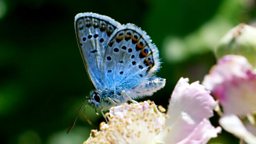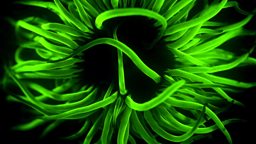3 Things to See in Episode 3
Silver-studded Blue (Plebejus argus)

The silver-studded blue is a fascinating and beautiful butterfly that can be found in the coastal regions of Wales, mostly in the north of the country, including Anglesey. Only the males of the species have the beautiful blue colouring that gives the insect its name - the females tend to be a duller shade of brown.
One of the amazing things about this species is that as caterpillars they form a unique relationship with black ants. The caterpillar secrets a fluid that the ants can feed on. Having provided food for the insects as a caterpillar it then reaps the rewards when it emerges from its chrysalis much later. The ants remember the favour and return it by forming a bodyguard around the butterfly at its most vulnerable stage. As it waits for its wings to dry ,the butterfly is defenceless and unable to fly away, so the ants protect their former feeder from any threat - including other butterflies who have emerged earlier.
Sundew (Drosera)

Sundews are named after the sweet-smelling drops of nectar secreted from tentacles that protrude from their leaves. This nectar acts as a glue so when an insect or bug stops to drink the liquid, they are caught in a sticky trap. The bugs' struggles to get free triggers a response in the plant that does two things: curls the leaves around the insect to get maximum surface coverage and then releases digestive enzymes that turn the bug into a liquid so it can be absorbed and digested.
The plant can typically be found in low-nutrient soil, hence the need for a dietary supplement. In episode 3, we see an ant fighting to escape a sundew in the Preseli Mountains. There are three species of sundew found in Wales, and one rarely recorded hybrid.
Snakelock anemone (Anemonia viridis)

Snakelock anemones are found in the Eastern Atlantic and along the entire coastline of Wales. The anemone will typically feed on anything it can digest, whether it be a small fish or a crustacean. The anemone is commonly found in rockpools and can handle a significant amount of time out of the water. The species reproduces through asexual division. Essentially, when the conditions are right a snakelock anemone will halve itself, producing two organisms from one. Its bright green colour is a result of a mix of algae and proteins stored within the anemone’s tentacles.
